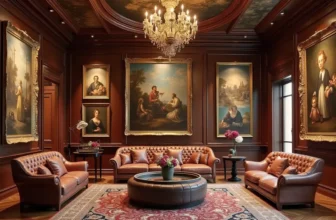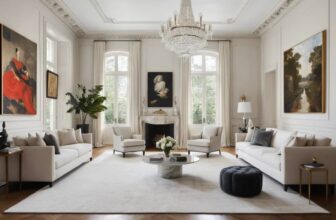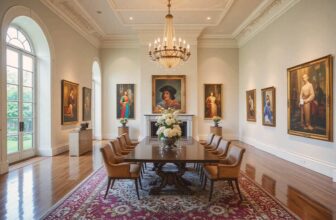Iconic Interior Designers Who Work with Million-Dollar Art
A Deep Dive into Luxury Interiors and High-Value Collections
Shopping Ads: Invest in Hidden Masterpiece: Rare Antique Oil Paintings For Sale. Limited Originals Available 💰😊 Are you looking for authentic hidden masterpiece? Explore old master antique oil paintings from the Renaissance and Baroque eras. From 16th-century portraits to 18th-century landscapes. Authenticity guaranteed, Old Master antique oil paintings for sale. Shop Now! 🎨 Renaissance And Baroque Art Old Master Portrait Paintings Landscape Antique PaintingsThe world of luxury interior design isn’t just about furniture, lighting, and color palettes, it’s about creating spaces that transcend decoration and become cultural statements. At the highest level of this craft, interior designers collaborate with multi-million-dollar art collections to curate environments that are as much about storytelling as they are about elegance.
Whether it’s a priceless painting by Pablo Picasso, a rare sculpture by Jeff Koons, or a blue-chip contemporary piece by Yayoi Kusama, these designers understand how to integrate art into architecture and lifestyle. Their projects often grace the world’s most exclusive penthouses, estates, and yachts, setting the standard for art-driven luxury interiors.
In this article, we’ll explore some of the most iconic interior designers who work with million-dollar art, how they collaborate with collectors, their design philosophies, and why their work stands out in the global luxury market.
Why Art Is Central to Ultra-Luxury Interior Design
High-net-worth individuals often view their homes as more than living spaces, they are personal museums that showcase taste, power, and investment. For these clients, art is not just décor; it’s an asset class and a cultural marker.
Luxury interior designers working in this sphere must:
Understand the market value and provenance of fine art.
Design spaces that enhance and protect the art while complementing the architecture.
Collaborate with curators, auction houses, and galleries to source and place works.
Manage security, lighting, humidity control, and display logistics for priceless collections.
The following designers have become synonymous with this rarefied niche, curating environments where interior design and fine art coexist in perfect harmony.
1. Peter Marino , The Architect of Artful Luxury
Few names are as revered in the world of art-centric design as Peter Marino. Known for his bold, architectural approach, Marino is not just an interior designer but a cultural force in the luxury world.
Signature Aesthetic
Marino’s projects are characterized by:
Minimalist architectural lines
Dramatic lighting
Rich textures and high-contrast palettes
Sculptural furniture that complements fine art
He is famous for incorporating works by leading contemporary artists, including Anselm Kiefer, Richard Serra, and Damien Hirst, into both private residences and flagship boutiques.
Collaborations with Major Brands
Marino has designed stores for luxury powerhouses such as Chanel, Louis Vuitton, and Dior, where art installations are often as central as the products themselves.
Art Integration
Marino often commissions site-specific works to ensure a perfect dialogue between the art and the architecture.
He treats spaces as galleries, with lighting carefully engineered to preserve and enhance each piece.
His own art collection is world-class, giving him an insider’s perspective on art curation.
2. Axel Vervoordt , The Master of Understated Elegance
Belgian designer Axel Vervoordt is celebrated for his refined minimalism and soulful interiors that allow art to breathe. Collectors around the world turn to him to create spaces that elevate rather than overshadow their collections.
Signature Aesthetic
Neutral color palettes
Natural materials like linen, wood, and stone
Japanese wabi-sabi influences
A focus on balance, light, and serenity
Notable Projects
Vervoordt is famously behind the serene aesthetic of Kanye West and Kim Kardashian’s Los Angeles home, a minimalist sanctuary that functions as an architectural gallery.
Art Integration
He believes in creating silence in a room so the art can “speak.”
He often juxtaposes contemporary and ancient works, revealing timeless beauty across eras.
His interiors feel curated, not decorated, a philosophy that appeals to serious collectors.
3. Kelly Wearstler , The Queen of Bold Statements
Kelly Wearstler is one of America’s most recognizable interior designers. Known for her fearless use of color, form, and material, she brings a distinctive energy to spaces where high-value art plays a starring role.
Signature Aesthetic
Sculptural, maximalist interiors
Bold patterns and materials
Strong geometric lines
A mix of vintage and contemporary pieces
Celebrity and Collector Clientele
Wearstler’s clientele includes A-list celebrities, luxury hotels, and major property developers. Her ability to turn art into the focal point of a design has made her a go-to for clients with significant collections.
Art Integration
Wearstler often treats art as functional architecture, integrating large-scale sculptures and installations.
She collaborates with contemporary artists, ensuring each space feels like a living gallery.
Her designs balance glamour with narrative, making art both elevated and approachable.
4. Robert Couturier , Timeless Grandeur Meets Modern Art
Robert Couturier’s interiors blend old-world refinement with modern sensibilities. Known for lavish yet livable spaces, he works closely with collectors to harmonize classic interiors with contemporary art.
Signature Aesthetic
Neoclassical references
Rich fabrics and textures
Eclectic mix of periods
Refined symmetry and detail
High-Profile Commissions
Couturier has designed for aristocrats, billionaires, and global collectors who trust him to integrate museum-quality art into historically significant estates.
Art Integration
Couturier often creates rooms that frame artwork like jewelry.
He balances architectural heritage with modern acquisitions, ensuring no piece feels out of place.
His approach is intellectual and narrative-driven, making each room tell a story.
5. Joseph Dirand , The French Minimalist Visionary
Joseph Dirand is a French designer celebrated for his restrained elegance. His spaces are serene, structured, and architecturally pristine, making them ideal backdrops for high-value art collections.
Signature Aesthetic
Parisian modernism
Minimalism with warmth
Elegant stonework and monochromatic tones
Clean lines that emphasize spatial volume
Notable Projects
Dirand has worked on prestigious private homes and flagship stores for brands like Balmain and Rick Owens, where art and architecture are seamlessly intertwined.
Art Integration
Dirand treats walls and spaces as frames for artworks.
He favors subtle backdrops, letting paintings and sculptures command attention.
His work often appeals to blue-chip collectors who prefer quiet sophistication.
6. India Mahdavi , The Color Maestro
India Mahdavi is renowned for her playful use of color, sensual curves, and distinctive textures. She approaches art as part of a vibrant conversation rather than a silent showpiece.
Signature Aesthetic
Jewel-tone palettes
Playful, modern forms
Fluid, organic shapes
Strong emotional resonance
Notable Projects
Mahdavi is behind some of the most Instagram-famous interiors, including the iconic pink dining room at Sketch London. Her ability to pair bold interiors with statement art makes her a favorite among fashion-forward collectors.
Art Integration
Mahdavi uses color to enhance and echo artworks, creating immersive environments.
She collaborates with artists to produce custom installations.
Her spaces often blur the line between art and design.
7. Jean-Louis Deniot , The Modern Classicist
Jean-Louis Deniot is known for his elegant fusion of classical style and modern restraint. His interiors often feature blue-chip art displayed with architectural precision.
Signature Aesthetic
Muted, elegant palettes
Architectural detailing
Subtle glamour
Classical proportions with a contemporary twist
Clientele and Influence
Deniot’s client list spans royal families, collectors, and global tastemakers. His understanding of art as both design element and investment sets him apart.
Art Integration
Deniot often builds architectural symmetry around major works of art.
He works with curators to ensure artworks remain the visual anchor of each room.
His interiors feel timeless, making them ideal environments for valuable collections.
8. Victoria Hagan , The Purist of Light and Space
Victoria Hagan has built a career on understated luxury and architectural clarity. Her designs are often described as “new American classicism,” making them perfect for showcasing both modern and historical artworks.
Signature Aesthetic
Soft, neutral color palettes
Natural light emphasis
Clean lines and proportion
Warm minimalism
Notable Projects
Hagan’s work includes Manhattan penthouses, Hamptons estates, and Aspen retreats for collectors who prefer discretion and refinement.
Art Integration
Hagan’s neutral backdrops allow art to shine without visual competition.
She often creates art walls and dedicated gallery spaces within homes.
Her work is favored by clients with museum-level collections who value quiet elegance.
9. Francis Sultana , The Curator-Designer
Francis Sultana is not only an interior designer but also a gallerist and curator, giving him rare insight into how art and interiors intersect at the highest level.
Signature Aesthetic
Dramatic, sculptural spaces
Luxurious materials
Bold yet refined compositions
High contrast between art and architecture
Notable Projects
Sultana’s projects include grand residences in London, New York, and Europe for serious collectors and cultural patrons. He also serves as Artistic Director of the Marella Agnelli Foundation.
Art Integration
Sultana designs with the art collection in mind from the very beginning.
He often curates museum-quality displays in residential spaces.
His interiors blur the line between private home and public gallery.
10. Steven Gambrel , The Storyteller
Steven Gambrel’s interiors are rich with narrative and craftsmanship. Known for historically informed design, he skillfully incorporates million-dollar artworks into spaces that feel authentic and layered.
Signature Aesthetic
Americana influences
Moody, textured palettes
Custom millwork and detailing
A collector’s sensibility
Art Integration
Gambrel creates rooms that evoke a sense of place, giving art a meaningful context.
His designs are deeply personal, reflecting the collector’s story.
He often uses architectural framing to spotlight key artworks.
How These Designers Integrate Art and Interiors Seamlessly
What sets these iconic designers apart is their methodology. Working with million-dollar art requires more than taste, it demands technical precision, collaboration, and vision.
1. Lighting and Conservation
Art requires specialized lighting to preserve colors and textures without UV damage. Designers often work with museum-grade lighting systems and consultants to ensure optimal conditions.
2. Security and Climate Control
Collectors rely on designers to integrate hidden security systems, reinforced walls, and humidity control systems to safeguard artworks worth millions.
3. Spatial Planning
Art isn’t placed randomly. These designers plan entire floor layouts around major pieces. A single sculpture or painting can determine the axis of a room.
4. Custom Fabrication
From floating walls to bespoke plinths and glass casings, custom fabrication ensures each artwork feels intentionally integrated.
5. Narrative Curation
Designers and collectors collaborate to build a coherent narrative, whether it’s showcasing postwar American art, European Old Masters, or contemporary installations.
The Role of Designers in the Art Market Ecosystem
Interior designers working in this sphere are not just decorators, they are influencers in the global art ecosystem. They often work alongside:
Auction houses such as Christie’s and Sotheby’s.
International art fairs like Art Basel.
Major galleries and artist studios.
Their influence can increase the perceived and market value of artworks, as collectors trust their taste and curatorial vision.
How Art Drives Design in Ultra-Luxury Homes
The Commission
A private collector in New York purchases a large-scale sculpture by Anish Kapoor for several million dollars. The sculpture is 10 feet tall, reflective, and requires controlled lighting.
The Design Brief
The interior designer is tasked with building the living room around the sculpture.
The Solution
The designer reorients the floor plan, ensuring the sculpture is the visual anchor.
Lighting is engineered to highlight its reflective qualities without heat or UV damage.
A neutral, modernist palette ensures no element competes visually.
The ceiling and floor are structurally reinforced to support its weight.
Furniture placement creates 360-degree sightlines, turning the room into a mini gallery.
This level of detail reflects how integral art can be to architectural and interior decisions at the ultra-luxury level.
Investment and Emotional Value of Art in Interiors
Art isn’t just about beauty, it’s also about financial and emotional investment. When designers work with million-dollar art, they are dealing with:
Cultural heritage , artworks by artists like Mark Rothko or Joan Mitchell carry historical weight.
Asset appreciation , fine art can outperform traditional investments in certain markets.
Legacy building , collectors see their homes as intergenerational estates.
Personal expression , art reflects the owner’s identity and worldview.
Interior designers who understand this duality between finance and feeling are invaluable to their clients.
The Technical Side: Preserving Priceless Works
Integrating million-dollar art comes with logistical and conservation challenges. Designers must collaborate with art handlers, conservators, and engineers to ensure:
Stable humidity and temperature to prevent warping or fading.
Low-UV, museum-grade lighting to preserve pigments.
Vibration control, especially for sculptures and fragile works.
Secure mounting systems that are invisible but robust.
Insurance compliance and documentation protocols.
This behind-the-scenes precision is what makes luxury art interiors feel effortless yet function flawlessly.
Global Hotspots for Art-Driven Interior Design
Certain cities are global hubs where luxury interiors and fine art converge, driving demand for top-tier designers:
New York , Home to major collectors and art institutions.
London , A historic art capital with an elite collector base.
Paris , Where fashion, art, and design intersect.
Los Angeles , Rising center for contemporary art collectors.
Dubai and Hong Kong , Emerging hubs for global wealth and blue-chip collections.
These cities are also centers for top auction houses, galleries, and design studios, making them fertile ground for art-integrated interior design.
How Designers Collaborate with Art Advisors and Curators
Most high-level projects involve not just designers but entire teams:
Art advisors help clients build collections and guide acquisitions.
Curators shape thematic narratives for display.
Architects ensure structural compatibility.
Lighting designers fine-tune presentation.
Interior designers act as the orchestrators, ensuring the result is a cohesive, immersive environment.
The Rise of Bespoke Art Commissions in Interior Design
More collectors are commissioning custom artworks for their homes. This allows designers to influence the creation process, ensuring perfect integration.
Examples include:
Murals and wall installations
Large-scale sculptures for atriums
Ceiling art integrated with lighting
Site-specific multimedia works
These collaborations turn interiors into living works of art in their own right.
How Technology Is Changing Art Integration
Modern luxury interiors leverage cutting-edge technology to display and preserve art:
Smart lighting systems adjust automatically to protect artworks.
Invisible climate control ensures preservation without compromising aesthetics.
Augmented reality planning allows designers and collectors to visualize pieces in situ before purchase.
Art storage and rotation systems let collectors change displays seasonally without damage.
This fusion of technology and artistry represents the future of ultra-luxury interior design.
Sustainability and the Future of High-End Art Interiors
Sustainability is becoming a growing concern, even in the luxury market. Designers are:
Choosing eco-friendly materials for framing and mounting.
Using energy-efficient lighting to protect art and the planet.
Working with artists who prioritize sustainable practices.
Restoring and reusing vintage materials rather than overproducing.
This trend reflects a broader cultural shift in luxury, where taste aligns with responsibility. image/ Chairish




